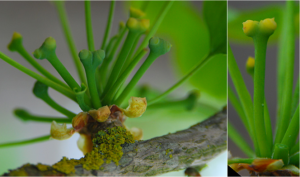Abstract
Premise: The Rubiaceae are ideal for studying the diversity of fruits that develop from flowers with inferior ovary. We aimed to identify morpho‐anatomical changes during fruit development that distinguish those derived from the carpel versus the extracarpellary tissues. In addition, we present the fruit genetic core regulatory network in selected Rubiaceae species and compare it in terms of copy number and expression patterns to model core eudicots in the Brassicaceae and the Solanaceae.
Methods: We used light microscopy to follow morphoanatomical changes in four selected species with different fruit types. We generated reference transcriptomes for seven selected Rubiaceaespecies and isolated homologs of major transcription factors involved in fruit development histogenesis, assessed their homology, identified conserved and new protein motifs, and evaluated their expression in three species with different fruit types.
Results: Our studies revealed ovary‐derived pericarp tissues versus floral‐cup‐derived epicarp tissues. Gene evolution analyses of FRUITFULL, SHATTERPROOF, ALCATRAZ,INDEHISCENT and REPLUMLESS homologs suggest that the gene complement in Rubiaceae is simpler compared to that in Brassicaceae or Solanaceae. Expression patterns of targeted genes vary in response to the fruit type and the developmental stage evaluated.
Conclusions: Morphologically similar fruits can have different anatomies as a result of convergent tissues developed from the epicarps covering the anatomical changes from the pericarps. Expression analyses suggest that the fruit patterning regulatory network established in model core eudicots cannot be extrapolated to asterids with inferior ovaries.
Salazar-Duque, H., Alzate, J. F., Trujillo, A. Urrea, Ferrándiz, C., and Pabón-Mora, N.. 2021. Comparative anatomy and genetic bases of fruit development in selected Rubiaceae (Gentianales). American Journal of Botany 108(10): 1838– 1860. https://doi.org/10.1002/ajb2.1785



